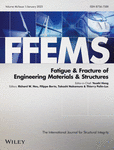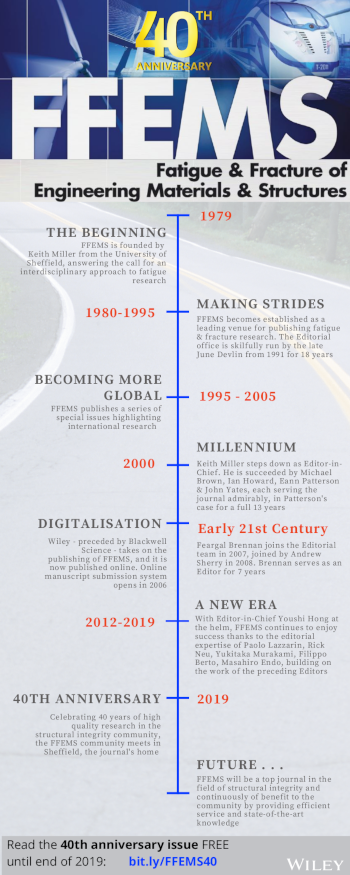Journal list menu
Export Citations
Download PDFs
ISSUE INFORMATION
ORIGINAL ARTICLES
Low cycle fatigue behavior of Cu-Cr-Zr alloy with different cold deformation
- Pages: 3-16
- First Published: 05 October 2022
- Bauschinger effect was found in LCF behavior of Cu-Cr-Zr alloys.
- The microstructure changes before and after LCF test were observed.
- The LCF life of Cu-Cr-Zr alloy may not be improved by large cold deformation.
- The LCF behavior of Cu-Cr-Zr alloy was consistent with Manson–Coffin–Basquin formula.
In situ experimental study on fracture toughness and damage mechanism of TiB2-reinforced steel matrix composites
- Pages: 17-31
- First Published: 30 September 2022
- TiB2-reinforced SMCs with 9 vol% and 13 vol% are prepared by eutectic solidification
- The fracture property of SMCs is investigated through in situ three-point bending tests
- Hot rolling effectively improves the tensile strength and fracture toughness of SMCs
- Optimized particle characteristics and matrix plasticity enhance the fracture resistance
Effect of laser-scan strategy on microstructure and fatigue properties of 316L additively manufactured stainless steel
- Pages: 32-48
- First Published: 03 October 2022
Experimental tests and FE simulations to compute the mechanical and fracture properties of the shot-earth 772
- Pages: 49-62
- First Published: 04 October 2022
- The mechanical and fracture characterization of shot-earth 772 is performed.
- Flexural, compression and fracture tests are carried out on the shot-earth specimens.
- Numerical analyses are performed by using a homemade micromechanical finite element model.
- Flexural behavior and fracture behavior of shot-earth 772 are numerically simulated.
Effect of stress wave propagation phenomenon on the determination of strain energy density theory parameters and dynamic J-integral
- Pages: 63-79
- First Published: 03 October 2022
- Stress wave propagations strongly influence the behavior of dynamic fracture problems.
- Averaging dynamic J-integrals from multiple domain sizes yields accurate results.
- The locations of minimum global energy densities are determined by wave propagations.
- Computations are handled with new capabilities added to FRAC3D program.
Validation of time temperature superposition principle for high modulus asphalt concrete in the linear viscoelastic and fatigue domains
- Pages: 80-95
- First Published: 26 September 2022
- Same shift factor (aT) in the linear viscoelastic (LVE) and fatigue domains.
- Superimposed Fatigue curves in equivalent time confirm the validity of the TTSP.
- Fatigue lives at different that respects TTSP are not statistically different.
- Recovery path after fatigue loading periods also verified TTSP.
Evaluating MTS criterion in predicting mixed-mode crack extension under different loading conditions
- Pages: 96-110
- First Published: 26 September 2022
- The suitability of the MTS criterion is examined under different loading conditions.
- Under indirect tensile loading, the MTS criterion overestimates crack initiation angle.
- The MTS criterion underestimates the angle in the specimen under 3-point bending.
- Initiation angle can be predicted properly based on stress distribution around crack tip.
Fatigue failure modes of rib-to-deck joints under the multiaxial stress states caused by various wheel loading characteristics
- Pages: 111-124
- First Published: 01 October 2022
- Multiaxial stress for rib-to-deck joints in various wheel loading cases was calculated.
- Equivalent structural stress was calculated to analyze the fatigue failure modes.
- Effect of wheel loading position and quantity on the fatigue failure mode were discussed.
- Failure mode transition for welded joint in the wheel load moving process was analyzed.
Experimental and theoretical investigation on mechanical behaviors of TB991 weld sealant under cyclic loading
- Pages: 125-136
- First Published: 01 October 2022
- TB991 weld sealant was experimentally investigated under cyclic loading conditions.
- The evolution of relaxation stress, cyclic softening, and dissipated energy was investigated.
- A constitutive model was proposed to describe the mechanical behavior of the material under cyclic loading conditions.
- The proposed model can consider the cyclic stress relaxation and cyclic softening of the materials.
Sensitivity and uncertainty analysis for structural health monitoring with crack propagation under random loads: A numerical framework in the frequency domain
- Pages: 137-152
- First Published: 05 October 2022
- A framework for sensitivity analysis of fatigue crack under random loads is presented.
- A probabilistic estimation of the remaining useful life is obtained.
- Uncertainty analysis can help improve the development of SHM systems.
Thermometric investigations for the characterization of fatigue crack initiation and propagation in Wire and Arc Additively Manufactured parts with as-built surfaces
- Pages: 153-170
- First Published: 02 October 2022
- Fatigue cracks on as-built WAAM surfaces can be monitored via infrared thermography.
- Fatigue life of as-built WAAM samples is dominated by a crack propagation phase.
- The link between surface stress concentration and crack initiation is nondeterministic.
Self-heating measurements under cyclic loading to identify history effects on HCF properties of high-strength low-alloy steel: Part I—Experimental investigations
- Pages: 171-181
- First Published: 30 September 2022
- Study of load history effects on HCF properties by means of self-heating measurements.
- Focusing on two load history: plastic pre-strain and a cyclic pre-loading.
- Reducing dedicated-time for fatigue characterization.
Cyclic stress–strain response and crystal plasticity finite element analysis of AISI 9310 steel in biaxial fatigue loading
- Pages: 182-198
- First Published: 17 October 2022
Softening response of cast Al-Si-Cu samples tested under low-cycle-fatigue and fatigue-creep regime and elevated temperate: Experimental and analysis
- Pages: 199-211
- First Published: 08 October 2022
- The softening behavior of LCF and LCFC was experimented and studied.
- The microstructure evolution of LCF and LCFC were studied.
- The effect of creep on LCFC and the fracture mechanism of LCFC were investigated.
- An improved modified model was established by combining Chaboche model and θ-projection model
Data-driven prediction of the probability of creep–fatigue crack initiation in 316H stainless steel
- Pages: 212-227
- First Published: 17 October 2022
Bayesian optimized collection strategies for fatigue strength testing
- Pages: 228-243
- First Published: 08 October 2022
- We present anopen-source Bayesian analysis for fatigue data.
- Bayesian maximum entropy sampling is used in novel protocols for fatigue testing.
- Better efficiency in measuring fatigue behavior was demonstrated.
- Methods were verified through mesoscale ultrasonic experiments.
A generalized model for dynamic mixed-mode fracture via state-based peridynamics
- Pages: 244-258
- First Published: 04 October 2022
- Mixed-mode I/II dynamic fracture via state-based peridynamics for the first time.
- Obtaining fracture angles directly via peridynamics without calculating stress intensity factors (SIFs).
- Properly predicting dynamic effects on mixed-mode I/II fracture behavior.
- Supporting the proposed model by various examples and previous literature results.
Multi-scale analyses on mechano-electric degradation of film interconnects in flexible electronics
- Pages: 259-270
- First Published: 13 October 2022
- A multi-scale mechano-electric degradation model for film interconnect is developed.
- The combined effect of thickness and grain size is reflected in the proposed model.
- Damage and electrical degradation of film interconnect can be effectively predicted.
- Films less affected by pre-stretching are also suitable for the proposed model.
A comparative study on fatigue indicator parameters for near-α titanium alloys
- Pages: 271-294
- First Published: 10 October 2022
- Comparative study of is performed on different fatigue indicator parameters in the same CPFE framework.
- Some FIPs show similar critical sites and crystallography thereof, consistent with experimental data.
- CP results of these FIPs capture the experimental orientation range transition of critical sites from pure to dwell fatigue load.
- Proposed FIP, solely based on dislocation density, is validated through comparison with other FIPs and experiments.
Low-cycle fatigue characteristics and fracture behavior of the die-forged 2014 aircraft wheel
- Pages: 295-309
- First Published: 10 October 2022
- A new die forging method was used to fabricate the aircraft wheel.
- Fatigue characteristics and fracture behavior of aircraft wheels were explored.
- The accuracy of different fatigue life prediction models was evaluated.
- Coarse Al12(MnSi)2(FeCu) intermetallic particles affected fatigue crack initiation.
An experimental study on residual stress relaxation in low-cycle fatigue of Inconel 718Plus
- Pages: 310-324
- First Published: 12 October 2022
- Residual stress relaxation in low-cycle fatigue is experimentally evaluated.
- Residual stress relaxation occurs if a threshold value of stress–strain state is reached.
- A two-stage analytical model based on the plastic strain energy W per cycle is proposed.
Fatigue crack propagation behavior of multiphase microstructure in a quenched and partitioned medium-carbon bainitic steel
- Pages: 325-340
- First Published: 20 October 2022
- The B-QP sample exhibits a lower FCP rate and higher fatigue threshold.
- The crack tortuosity and secondary cracks are the mainly reasons for the lower FCP rate.
- The B-QP sample shows a pronounced small plateauing caused by the mechanical twinning.
Multiaxial low cycle fatigue behavior and life prediction of CP-Ti under non-proportional stress-controlled mode
- Pages: 341-356
- First Published: 23 October 2022
LETTER TO THE EDITOR
Crack propagation through weld and heat affected zone
- Pages: 357-360
- First Published: 10 October 2022





